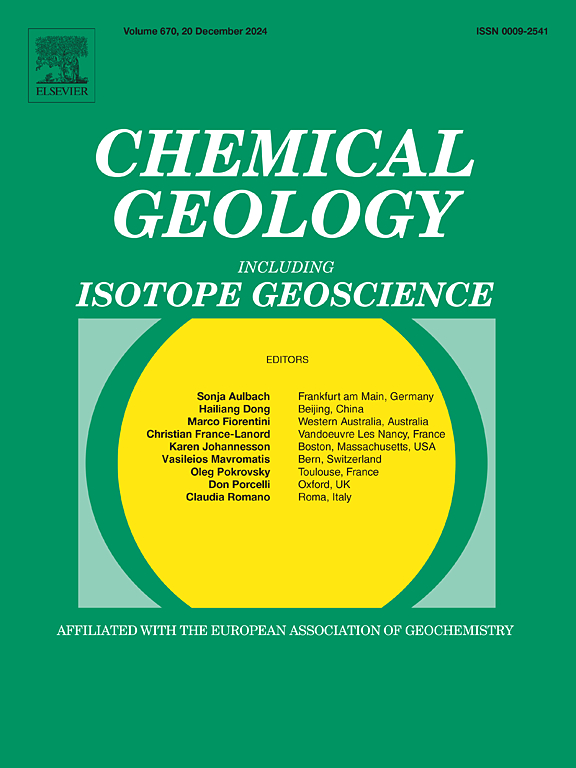Geochemistry of sediment precipitated during acid mine drainage-seawater interaction. Implications for metal mining impacts on estuarine systems
IF 3.6
2区 地球科学
Q1 GEOCHEMISTRY & GEOPHYSICS
引用次数: 0
Abstract
Metal-mining pollution impacts estuarine systems, where sediments with high available toxic metal concentrations precipitate. In the Ría de Huelva estuary (SW Spain), the metal-rich acidic water of the Tinto River (headwater pH = 2.2 and electrical conductivity -EC- = 25.8 mS cm−1) interacts with saline-alkaline seawater of the Atlantic Ocean (pH = 7.87, EC = 55.2 mS cm−1). This study analyses the geochemical characteristics of the dissolved and particulate fractions formed when mixing both systems. A pH-controlled test showed that about 2000 L of seawater are necessary to neutralise 1 L of Tinto River headwater. A six-step sequential extraction performed on the precipitated sediments indicated that: a) Fe, Al, Zn, Cu, ∑REE, Co, Pb, and As are highly available in soluble and adsorbed fractions; b) Fe, Al, Cu, Zn, ∑REE, Mo, and Co mostly concentrate in iron oxy-hydroxides and oxyhydroxysulfates; and c) As, V, Mo, U and Pb desorb at pH ≥ 5. Furthermore, Fe and Al precipitates play significant hydrochemical and environmental roles in the studied environment by attenuating pH changes, as sediment precipitation decreases pH and captures chemical elements. The results of this study are useful to better understand natural processes (e.g., disruption of buffers, instability of dissolved elements, sorption/desorption, co-precipitation) taking place in estuaries affected by AMD and to predict geochemical variations in the environment due to climate change (e.g., floods, extreme precipitations, sea level rise).
酸性矿井排水-海水相互作用过程中沉淀沉积物的地球化学特征。金属开采对河口系统的影响
金属开采污染影响河口系统,其中含有高有效有毒金属浓度的沉积物沉淀。在Ría de Huelva河口(西班牙西南部),Tinto河的富金属酸性水(源头pH = 2.2,电导率-EC- = 25.8 mS cm - 1)与大西洋的盐碱海水(pH = 7.87, EC = 55.2 mS cm - 1)相互作用。本研究分析了两种体系混合时形成的溶解组分和颗粒组分的地球化学特征。一项ph控制试验表明,大约需要2000升的海水来中和1升的Tinto河水源。对沉淀沉积物进行了6步序萃取,结果表明:A) Fe、Al、Zn、Cu、∑REE、Co、Pb、As在可溶性和吸附组分中均有较高的富集度;b) Fe、Al、Cu、Zn、∑REE、Mo、Co主要富集在铁氧羟基化物和氧羟基硫酸盐中;c) As、V、Mo、U、Pb在pH≥5时解吸。此外,Fe和Al沉淀在研究环境中通过减弱pH变化发挥了重要的水化学和环境作用,因为沉积物降水降低了pH并捕获了化学元素。本研究的结果有助于更好地理解受AMD影响的河口发生的自然过程(如缓冲层的破坏、溶解元素的不稳定性、吸附/解吸、共沉淀),并预测气候变化引起的环境地球化学变化(如洪水、极端降水、海平面上升)。
本文章由计算机程序翻译,如有差异,请以英文原文为准。
求助全文
约1分钟内获得全文
求助全文
来源期刊

Chemical Geology
地学-地球化学与地球物理
CiteScore
7.20
自引率
10.30%
发文量
374
审稿时长
3.6 months
期刊介绍:
Chemical Geology is an international journal that publishes original research papers on isotopic and elemental geochemistry, geochronology and cosmochemistry.
The Journal focuses on chemical processes in igneous, metamorphic, and sedimentary petrology, low- and high-temperature aqueous solutions, biogeochemistry, the environment and cosmochemistry.
Papers that are field, experimentally, or computationally based are appropriate if they are of broad international interest. The Journal generally does not publish papers that are primarily of regional or local interest, or which are primarily focused on remediation and applied geochemistry.
The Journal also welcomes innovative papers dealing with significant analytical advances that are of wide interest in the community and extend significantly beyond the scope of what would be included in the methods section of a standard research paper.
 求助内容:
求助内容: 应助结果提醒方式:
应助结果提醒方式:


